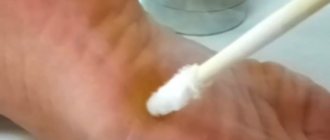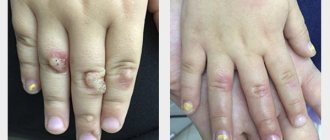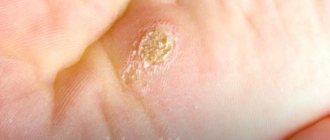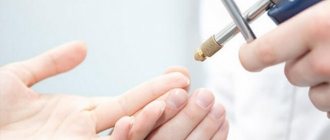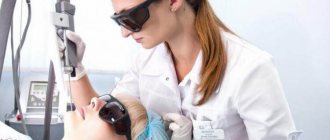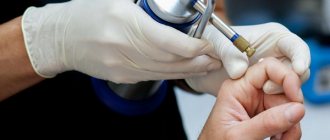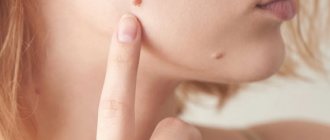Papillomas can be localized in any area of the skin. The most common places for the localization of benign neoplasms of the skin and mucous membranes are the skin of the folds of the neck, axillary zones, inguinal-femoral folds and pubis, genitals and gluteal folds, and perianal zone. This is due to the fact that in these places the skin is most susceptible to friction and the appearance of microtraumas, through which the human papillomavirus (HPV) enters from an infected environment.
The source of HPV infection is a sick person (through direct bodily or sexual contact) and objects contaminated with the virus (towels, washcloths, razors).
The incubation period of human papillomavirus infection ranges from two weeks to several years.
It is also possible that papillomas may appear on the mucous membranes of the lips and mouth, nose, external genitalia, vagina and cervix. With HPV infection of the cervix, dysplasia occurs - changes in the cellular composition of the mucosa, which increases the risk of cervical cancer. There are several dozen varieties of HPV, oncogenic - papillomavirus types 16 and 18, which can be identified by DNA testing (PCR) of a cervical scraping.
In appearance, papillomas on the skin look like neoplasms that protrude above the skin level in the form of hemispherical flat nodules or threads of soft and moderately dense consistency ranging in size from 1 mm to 5–7 mm. Neoplasms can have a “thin stalk” or a wider base. Papillomas usually have the color of the surrounding skin, sometimes there is a pink tint in the lesions.
Papillomas in the area of the external genitalia are called genital warts. They are transmitted through intimate contact (a condom does not always protect against this infection). Condylomas acuminata have the appearance of soft elastic formations of pink color on a thin stalk with a papillary surface, reminiscent of the appearance of a “cockscomb” or “cauliflower”.
The size of condylomas usually does not exceed 5 mm, but when several elements group and merge, foci of condylomatosis with sizes up to several centimeters are formed.
What studies can be prescribed for a patient with papillomas?
If a patient is diagnosed with papillomas, he is usually prescribed:
- Examination for the full range of sexually transmitted infections: syphilis and HIV, gonorrhea, trichomoniasis, chlamydia, genitourinary mycoplasmosis. This is necessary in the case of genital papillomas. To do this, the patient undergoes blood sampling from a vein and a smear examination for urogenital infections from the lower parts of the genitourinary tract (urethra, vagina, cervix).
- Blood test for sugar, cholesterol and lipid profile, bilirubin and transaminases. A clinical blood test can be offered to the patient to exclude those underlying diseases that served as a prerequisite for the presence of multiple papillomas on the skin or mucous membranes.
- Blood test for cryoglobulins - in case of suspected cryoglobulinemia before using the cryodestruction method.
Women with manifestations of genital HPV infection are prescribed a smear test for oncocytology and colposcopy - an examination of the condition of the cervical mucosa under a magnifying device (colposcope).
How is papillomas removed with liquid nitrogen?
Before removing papillomas by cryodestruction, the patient undergoes a general clinical examination. This will identify the presence of contraindications, as well as assess the patient’s health status and the characteristics of warts (number, size, location). Comprehensive diagnostics includes:
- Examination by a dermatologist;
- Consultation with an anesthesiologist who will select the most optimal method of administering an anesthetic drug (if necessary);
- Examination by an oncologist (if the wart is suspected of being malignant);
- Laboratory research.
The procedure for removing papilloma by cryodestruction can be performed using a cryoprobe or manually using a cotton applicator. Anesthetic drugs are used in cases where the wart is large, has grown into the deep layers of the epidermis or is located on sensitive areas of the body (intimate area, face, neck, etc.).
If papillomas are removed from the face, the specialist before the procedure cleanses the skin of cosmetics and treats the surgical field with disinfectants and antiseptics. Then a special gel is applied to the skin, which softens the top layer of the epidermis, making it more elastic. This promotes deep cold effects. If the procedure is performed using anesthesia, the doctor will use an anesthetic (cream, gel, injection). To protect healthy surrounding tissues from damage and freezing, a wooden applicator is installed. After this, the specialist begins to cauterize the papillomas.
Under the influence of low temperatures, pathologically altered cells freeze and die. The painfulness of the procedure for removing papillomas by cryodestruction will depend on the individual sensitivity of the patient and the clinical characteristics of the warts. Typically, a person experiences a slight burning and tingling sensation during the first few seconds. As the pathological cells freeze, the discomfort goes away. The duration of the procedure depends on the number, size, location and distribution of warts.
After the initial exposure, the doctor takes a short break for 2-3 minutes so that the epidermal cells thaw. Then, having visually assessed the intensity and depth of cold exposure, the specialist decides on the advisability of repeated cryotherapy in this area or cauterization of subsequent papillomas (in the presence of multiple warts).
After cryodestruction is completed, antibacterial and restorative agents are applied to the treated areas. This will relieve discomfort after the procedure and speed up the wound healing process.
Stages of cryodestruction of papillomas
Cryodestruction of papillomas does not require special preliminary preparation. Anesthesia is not performed, since there is a short-term exposure to cold on the lesion (from 5 to 40 seconds). Cryodestruction is carried out as follows:
- The patient frees the treatment area from clothing and takes a comfortable position on the couch.
- There are 2 methods of influencing liquid nitrogen on neoplasms: application and aerosol (non-contact). When applying freezing, a cotton swab “on a stick” or tweezers is used, which is lowered into a container with liquid nitrogen and applied to the papilloma for 5–40 seconds. The time and area of exposure to cold are determined by the size of the papilloma. With the non-contact method of cryodestruction, nitrogen is supplied through the tip of a special device (cryodestructor) and sprayed onto the papilloma in the form of an aerosol.
- The process of removing papilloma using liquid nitrogen is gradual (on average up to 2–4 weeks). After freezing, the papilloma tissue mummifies and falls off in the form of a “crust.”
If the effect is insufficient, repeated cryodestruction of papillomas is possible. Skin scarring does not form after a correctly performed cryodestruction technique.
Features of the procedure
Removal of papillomas with nitrogen is usually carried out without any anesthesia. Some patients do not feel anything at all due to the fact that nerve fibers stop conducting pain impulses when they freeze. For other patients, the sensations are quite tolerable. When special tools are used for removal with liquid nitrogen, it goes very quickly and in one procedure you can easily get rid of all papillomas.
The healing time after nitrogen removal is further increased due to the fact that in the first days inflammation, swelling and rejection of dead papillomas cells occurs. Healing takes more than one week despite its small size. Before nitrogen removal, you should make an appointment in advance so that your doctor has nitrogen and tools prepared.
What are the contraindications for cryodestruction of papillomas?
Cryodestruction is contraindicated if:
- 1. The presence of cold allergies - the appearance of itchy rashes and hives when exposed to cold.
- 2. Cryoglobulinemia is a syndrome that is accompanied by the appearance in the blood of cryoglobulins - specific proteins that form and precipitate at temperatures below 37°C. This syndrome manifests itself in the form of weakness, joint pain and the presence of a hemorrhagic rash. Accompanies conditions such as blood diseases, vasculitis - inflammation of blood vessels, Raynaud's syndrome, viral hepatitis C, etc.
- 3. Suspicion of the presence of a malignant process in the formations to be removed. In this case, a method should be chosen that will provide a full histological examination of the removed tissue in the laboratory.
- 4. The presence of urogenital infections with genital warts. In this case, it is more advisable to sanitize the identified infections before cryodestruction.
Indications and contraindications for papilloma removal
Removal of papillomas with liquid nitrogen can be carried out not only at the request of the patient, but also if there are medical indications. These include:
- Suspicion of the malignancy of the wart;
- The presence of large and multiple growths;
- The appearance of painful and unpleasant sensations when pressing on the wart;
- The growth of neoplasms and the appearance of new growths;
- Bleeding from the wart or surrounding tissue.
Like any destructive method, cauterization of warts with liquid nitrogen has a number of limitations, in the presence of which cryodestruction can harm the patient’s health and lead to complications. Contraindications to cryotherapy for papillomas include:
- Increased sensitivity of the skin to cold exposure;
- Pregnancy, lactation period;
- The presence of rashes, inflammation and violations of the integrity of the epidermis in the area of the procedure;
- The course of acute inflammatory and infectious processes;
- Individual nitrogen intolerance;
- Chronic diseases in acute form;
- Epilepsy and other mental disorders;
- Increased body temperature;
- Heart failure, unstable blood pressure, hypertension.
What recommendations should the patient follow after cryodestruction of papillomas?
After performing cryodestruction, it is important:
- exclude for 3-4 weeks visiting the pool, swimming in open water, visiting baths and saunas;
- do not touch or injure the papilloma treated with nitrogen;
- bathe in the shower after first covering the outbreak with a bactericidal plaster (for the duration of bathing);
- maintain laundry hygiene.
If there is discharge, itching and painful redness of the skin in the area of the papilloma after cryodestruction, you must make an emergency appointment with a specialist.
Why are papillomas dangerous?
When papillomas appear from HPV viruses, they become a source of infection of other areas of the skin, to which the viruses spread when touched. Other papillomas may also appear there. In addition, HPV increases the likelihood of skin cancer. Occasionally, papillomas can become inflamed and fester, especially after injury. The main danger comes from an incorrect diagnosis, when the name “papilloma” actually hides cancer, melanoma or precancerous diseases. Particular care should be taken with regard to “papillomas” in the lips, mouth, tongue, genitals and anal areas. Papillomas of these localizations cannot be called papillomas - they are either warts or condylomas.
Sign up for a consultation
Benign neoplasms on the skin or papillomas are growths that constantly interfere with dressing and washing, can be accidentally touched and begin to bleed. If you do not get rid of such a defect in a timely manner, the chances of developing a malignant course increase sharply. Among the methods for removing papillomas, cryodestruction is considered the most popular.
Content:
The essence of the procedure
The cryodestruction technique involves cauterization of papillomas using liquid nitrogen. The method is based on the physical properties of a given chemical element. At low temperatures, the substance turns into a liquid form, which destroys soft tissue. In beauty salons, this procedure is carried out in two ways:
- Manual.
It is accessible because it is performed using a cotton swab. The main disadvantage of this method is the inability to apply a targeted dose of the substance. This leads to damage to healthy skin around the papilloma. - Hardware.
A procedure using a special device is more expensive than manual removal, but it has quite a significant advantage. The device provides a much more delicate application of the chemical and deep freezing, which improves the quality of the result.
Important! The second method is considered safer and more effective. It prevents damage to healthy areas of the dermis. Therefore, when there is such an opportunity, it is better not to save money, but to pay for hardware removal of papillomas.
Liquid nitrogen freezes the blood in the vessels located in the tumor. As a result of this effect, the papilloma becomes white because the cells of the viral growth stop receiving oxygen. Hypoxia damages and injures papillary tissue, and lymphocytes, rushing to the remains of the skin formation, finally complete the process when the dead epidermis is rejected and completely disappears.
Pharmacies sell medications that allow you to carry out the procedure at home, but only with the use of an applicator - a cotton swab. Experts do not recommend resorting to such manipulations, since both the growths themselves and healthy tissue can be injured.
Stages of cryodestruction
Removal of papillomas with liquid nitrogen is carried out only after consultation with a specialist. This step allows us to determine that the patient has no contraindications to the procedure, which are:
- inflammatory processes;
- infectious diseases;
- exacerbation of chronic pathologies;
- suspicion of cancer.
In the latter case, a referral for a biopsy is given, and in other situations, you will first need to undergo appropriate treatment. There is a group of patients with intolerance to low temperatures, so cryodestruction is completely contraindicated for them.
If there are no obstacles, cryodestruction is prescribed. In sensitive areas and with multiple localization of tumors, removal of papillomas with liquid nitrogen requires anesthesia. Pain relief can also be carried out when a person’s pain threshold is too low.
The procedure goes as follows:
- The doctor explains to the patient in advance about the unpleasant sensations of burning, tingling and pain, which are completely normal for this technique. If it is decided to undergo anesthesia, the affected area is treated with an antiseptic. Next, the doctor waits a certain time until the skin loses sensitivity.
- The specialist cauterizes the papilloma with an applicator (cotton swab) or using a special device. Liquid nitrogen is applied for 30 seconds, and then a one-minute break is required. In total, up to 3 destructions are performed per zone with a neoplasm. The specialist touches a little tissue around. This eliminates the reappearance of papilloma.
The total duration of cryodestruction depends on the number, size, and location of tumors. On delicate areas of the skin, removing papillomas with liquid nitrogen takes much longer, as it requires careful and delicate handling.
When are the results noticeable?
The procedure is highly effective, but the results are not immediately noticeable. First, swelling and bluish bubbles appear at the site of the treated tumors. Burn areas should not be touched. The film “ripens” and bursts on its own, and a crust forms in place of the bubble.
When the old cells die off completely, a pinkish mark remains after the wound, which will completely disappear quite soon. There are no scars left in the area where the papillomas were removed with liquid nitrogen. Healing takes from two to four weeks.
Rehabilitation period
To speed up the process of skin restoration and avoid complications, you must adhere to certain rules:
- Do not use decorative cosmetics, as well as various creams, until the crust goes away. This usually takes approximately 6-10 days.
- Do not wet the area where the papilloma was cauterized for the first three days.
- Do not “expose” the area exposed to liquid nitrogen to sunlight.
- Do not remove the bandage that the doctor has applied, and do not try in any way to speed up the removal of the existing crust.
After consulting with a specialist, you can purchase hydrocortisone ointment, which accelerates the regeneration of the epidermis. Doctors recommend using sunscreens to avoid skin pigmentation after the papilloma disappears.
How effective is cryodestruction?
Removal of papillomas with liquid nitrogen is positioned as a safe and effective procedure, but, like any other technique, it has some disadvantages:
- painful and not the most pleasant sensations during the procedure;
- the likelihood of changes in skin color, that is, pigmentation in the cauterization areas;
- local baldness if the papilloma was located on the scalp.
Important! If removal of papillomas with liquid nitrogen is carried out by an unqualified specialist, the root of the neoplasm may be processed poorly, which will lead to the reappearance of papillomas. Therefore, when choosing a clinic, you should carefully read the reviews about a particular doctor.
There are also some complications that you should be aware of in advance. The main risk is the inflammatory process as a result of mechanical damage to the bladder or crust during washing, or a deliberate desire to “speed up” healing.
This should not be done under any circumstances, which is what the specialist warns about when telling the patient about precautions during the rehabilitation period. You just need to wait a little until the bubble and crust go away and no complications arise.
If damage occurs, you should immediately consult a doctor. Otherwise, an infection will get into the opened wound and the process of rotting will begin, so you must contact a specialist immediately.
Summarizing
Removing papillomas with liquid nitrogen is an effective and safe procedure, but only when the patient turns to a highly qualified and experienced specialist and also follows all precautions during the rehabilitation period.
When is it necessary to remove formations using liquid nitrogen?
- sensation of cosmetic discomfort when located on the lyceum, eyelids and neck;
- genital form that can infect a partner;
- plantar version, causing pain and discomfort;
- location of the formation in a zone of constant friction;
- multiple forms of growths;
Contraindications to cryodestruction:
Before you sign up for the procedure, you must undergo a thorough examination by a specialist to find out the nature of certain formations.
- malignant nature of the formation
- individual intolerance to cold or nitrogen, but this is extremely rare.
- presence of acute infectious diseases
- high pressure
- epilepsy
